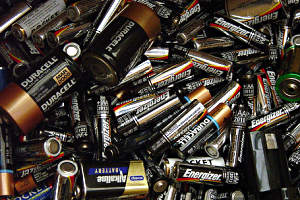 To store power for the grid, we'll need some bigger batteries.
To store power for the grid, we'll need some bigger batteries.
Credit: Heather Kennedy
"We believe energy storage is the next big thing," says Craig Horne, CEO of EnerVault, a Sunnyvale startup. His company is developing a battery that could help solve a renewable energy problem (check out our previous post): how to keep electricity flowing when we need it, even as more of it comes from sources we can't control. Horne was a panelist at a UC Berkeley-Stanford sponsored CleanTech Conference about energy storage held last week at Berkeley's Lawrence Hall of Science.
Proponents of energy storage think it has a key role to play in the future energy grid. A network of storage systems could act as a kind of shock-absorber, balancing the spikes and troughs of production that can come from solar and wind power. For example, if we had a way to store the power generated by wind turbines during a storm, we could release it later when demand gets high, making the power supply more constant.
We all use batteries daily – in cell phones or electronics – so it’s clear we already have the technology to store electricity and use it later. Unfortunately, that technology doesn't scale up very easily; batteries that can store enough energy to help smooth the grid are expensive, though company's like Horne's are hoping to change that. (For more on the challenges facing battery technology in particular, check out the QUEST TV story, Waiting for the Electric Car).
Batteries are just one strategy on the table, however; there are lots of ideas for how to store power at a large scale. One that's already in use in California is pumped-hydroelectric storage, which uses excess power to pump water from a low reservoir to a higher one. To get the energy back, you let the water flow the other direction, turning turbines to generate electricity as it drops in elevation. Compressed air energy storage (CAES), features a similarly clever use of the laws of physics, using excess power to compress air, which then releases energy as it expands later.
